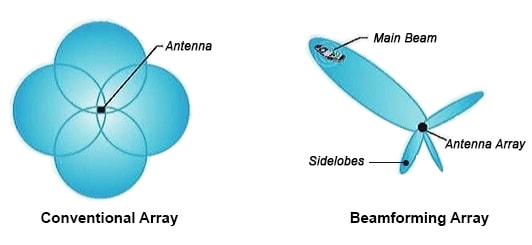In this article, I’ll start with its motivation. Then I’ll answer the question: What is Beamforming? And also discuss its types, especially Hybrid Beamforming.
Beamforming Motivation:
The 5G main goals are to achieve higher data rates, lower latency network accesses, and support and fix different use cases. With higher data rates, the need for wider bandwidth spectrums appears.
Nowadays, available bandwidth in the spectrum up through 6 GHz is no longer sufficient to satisfy the mentioned requirements. This, in turn, moved the target operating frequency bands up into the millimeter wave range for the next mobile generations.
The small wavelengths at these higher frequency bands empower applications with many antenna elements per system within tiny form factors. However, it also increases the signal-path and propagation challenges linked to operating at these frequencies.
These losses can be decreased with intelligent array design and the use of spatial signal processing techniques, including Beamforming. That type of processing techniques are enabled by large arrays. It can be utilized directly to provide higher link-level gains to overcome path loss and unwanted interference sources.
So we can agree that it overcomes the path loss issue at Higher Frequency Band.
Beamforming Definition:
It is a process to generate the radiated beam patterns of the antennas. By totally building up the processed signals in the direction of the desired terminals and abolishing beams of interfering signals.
But the question remains: How can it direct the signal to only the desired terminals?
It employs multiple antennas to control the direction of the antenna. It happens by properly weighting the magnitude and phase of separate antenna signals in an array of multiple antennas.
In this technique, each antenna element is fed alone with the signal to be transmitted. The phase and amplitude of each signal are then added constructively and destructively. All in a way that they focus the energy into a narrow beam or lobe.

Beamforming Benefits:
Its application has the following benefits:
- Enhanced Energy Efficiency: Massive MIMO systems are supported by beamforming processes to reduce the power consumption of the whole system. That happens by computing the optimal number of antenna elements that meet several crucial criteria for manipulating energy efficient massive MIMO systems.
- Improved Spectral Efficiency: It is the power controlling of the uplink and downlink signals. Also the employment of the information of the training sequence, and improvement of the signal quality by antenna elements. This allows for great capacity improvements.
- Increased System Security: Beamforming is to guide the transmitted signal toward the purposed user. So the receiver will be the only side to recover the wanted signal from the overlay signal.
Beamforming Types:
- Digital Beamformer: Each antenna element has its own corresponding baseband port offering the largest flexibility. However, a full digital beamformer with hundreds of antenna elements might be infeasible. Or at best feasible but lacking power and complex.
So, Digital Beamformer is heavy power consuming.
- Analog Beamformer: One baseband port supplies an analog beamforming network. Where its weights are utilized either directly on the analog baseband components, at some intermediate frequency, or at RF. However, in a multi-user environment, this can cause interference if pure beam separation is not applicable.
So, Analog Beamformer is not suitable for a multi-user environment.
- Hybrid Beamformer: It is a technique used to partition it between the digital and RF domains. System designers can use hybrid beamforming to balance flexibility and cost trade-offs. While at the same time fielding a system that meets the required performance parameters.
So Hybrid Beamformer enables a compromise with respect to complexity and flexibility between analog and full digital types.
Hybrid Beamforming:
Its designs are developed by gathering multiple array elements into subarray modules. A transmit/receive (T/R) module is dedicated to a subarray in the array. Thus, fewer T/R modules are needed in the system.
The number of elements and the positioning within each subarray can be chosen to ensure that system-level performance is accomplished across a range of steering angles.
Conclusion
The Hybrid beamforming type uses advantages of both analog and digital type. Here, precoding is used on both analog domain and digital domains. That means it employed precoding/beamforming at both radio frequency (RF) and baseband.
Therefore, it is adopted in millimeter wave radio used in the next generation mobile networks, mainly 5G.
